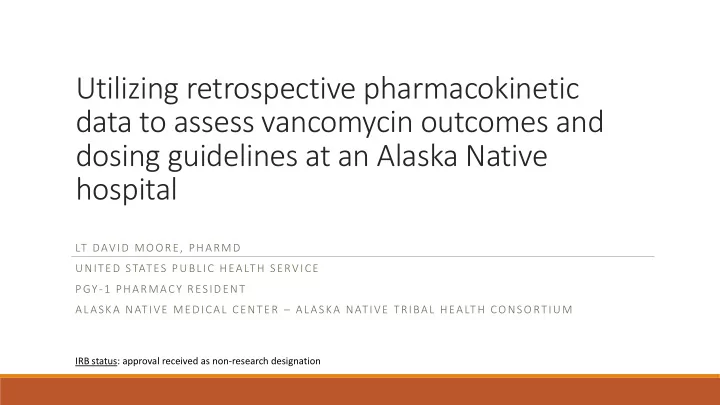

Utilizing retrospective pharmacokinetic data to assess vancomycin outcomes and dosing guidelines at an Alaska Native hospital LT DAVID MOORE, PHARMD UNITED STATES PUBLIC HEALTH SERVICE PGY-1 PHARMACY RESIDENT ALASKA NATIVE MEDICAL CENTER – ALASKA NATIVE TRIBAL HEALTH CONSO RTIUM IRB status: approval received as non-research designation
Disclosure Statement I, David Moore, do not have (nor does any immediate family member have) a vested interest in or affiliation with any corporate organization offering financial support or grant monies for this presentation, or any affiliation with an organization whose philosophy could potentially bias my presentation.
Learning Objectives 1. Recall the rationale for the use of AUC:MIC-led monitoring for vancomycin 2. Evaluate the difference between AUC:MIC and trough-led dosing strategies 3. Discuss considerations and approaches for implementing an institutional transition to AUC:MIC-led dosing
Institution Alaska Native Medical Center • 173-bed hospital • Serves Alaska Native/American Indian people living in Alaska • Wide range of care including emergency and acute management as well as primary care and a variety of specialties
Pre-Test Assessment Questions 1. Vancomycin pharmacodynamics exhibit which type of killing? a) Cmax:MIC b) AUC:MIC c) Time > MIC 2. Which of the following is true about AUC:MIC-led dosing compared to trough? a) AUC:MIC has less accuracy but less risk of nephrotoxicity b) AUC:MIC has greater accuracy and less risk of nephrotoxicity c) AUC:MIC has greater accuracy but greater risk of nephrotoxicity 3. If an institution wishes to implement AUC:MIC-led dosing for vancomycin, what is the best course of action? Select all that apply: a) Purchase Bayesian-based Software b) Develop your own calculator c) None of the above, AUC:MIC is too complicated
Background: Vancomycin Dosing & Monitoring • AUC:MIC (24 hr.) 1-2 • Elbert et al. In-vitro study in S. aureus murine models exhibiting predictive value of PK parameters for bactericidal activity • Moise-Broder et al . Clinical success with AUC:MIC >350 in S. aureus pneumonia OR = 7.19 (95% CI: 1.91-27.4) p =0.0036 • Trough 3 • Kullar R. et al. Found trough goal >15mg/mL v. <15mg/mL in MRSA bacteremia had less treatment failure: 48.6% v. 61.2% p =0.038
Background: AUC:MIC v. Trough • Trough may underestimate true AUC • Nephrotoxicity • Van Hal et al . Meta-analysis: troughs >15mg/mL were over twice as likely to be associated with vancomycin-induced nephrotoxicity: • Zakowski et al. AUC (24hr) > 677 mg*hr/L increased risk of nephrotoxicity Pai MP, Neely M, Rodvold KA, et al . Innovative approaches to optimizing the delivery of vancomycin in individual patients. Adv Drug Delivery Review . 2014(77)50-57.
Transitioning to AUC:MIC • Establish a plan for procedure/protocol development or revision • Assess cost-effectiveness of AUC-estimation strategies: • Bayesian software v. home-grown • Implementation: interdisciplinary buy-in and training • Pharmacy • Providers • Nursing • Microbiology Lab
Pre-Test Assessment Questions 1. Vancomycin pharmacodynamics exhibit which type of killing? a) Cmax:MIC b) AUC:MIC c) Time > MIC 2. Which of the following is true about AUC:MIC-led dosing compared to trough? a) AUC:MIC has less accuracy but less risk of nephrotoxicity b) AUC:MIC has greater accuracy and less risk of nephrotoxicity c) AUC:MIC has greater accuracy but greater risk of nephrotoxicity 3. If an institution wishes to implement AUC:MIC-led dosing for vancomycin, what is the best course of action? Select all that apply: a) Purchase Bayesian-based Software b) Develop your own calculator c) None of the above, AUC:MIC is too complicated
References 1. Ebert S. In vivo cidal activity and pharmacokinetic parameters for vancomycin against methicillin-susceptible and -resistant S. aureus [abstract 439]. In: Program and abstracts of the 27th Interscience Conference on Antimicrobial Agents and Chemotherapy (New York) Washington, DC American Society for Microbiology (pg. 1987 -173). 2. Moise-Broder, P.A., Forrest, A., Birmingham, M.C. et al. Pharmacodynamics of Vancomycin and Other Antimicrobials in Patients with Staphylococcus aureus Lower Respiratory Tract Infections. Clin Pharmacokinet 43, 925 – 942 (2004). https://doi.org/10.2165/00003088-200443130-00005. 3. Kullar R, Davis SL, Levine DP, et al. Impact of Vancomycin Exposure on Outcomes in Patients With Methicillin- Resistant Staphylococcus aureus Bacteremia: Support for Consensus Guidelines Suggested Targets, Clinical Infectious Diseases, Volume 52, Issue 8, 15 April 2011, Pages 975 – 981. 4. Pai MP, Neely M, Rodvold KA, et al . Innovative approaches to optimizing the delivery of vancomycin in individual patients. Adv Drug Delivery Review . 2014(77)50-57. 5. Van Hal SJ, Paterson DL, Lodise TP. Systematic review and meta-analysis of vancomycin-induced nephrotoxicity associated with dosing schedules that maintain troughs between 15 and 20 milligrams per liter. Antimicrob Agents Chemother . 2013;57(2):734 – 744. 6. Zasowski EJ, Murray KP, Trinh TD, et al. Identification of Vancomycin Exposure-Toxicity Thresholds in Hospitalized Patients Receiving Intravenous Vancomycin. Antimicrob Agents Chemother . 2017;62(1):e01684-17. Published 2017 Dec 21. doi:10.1128/AAC.01684-17.
Recommend
More recommend